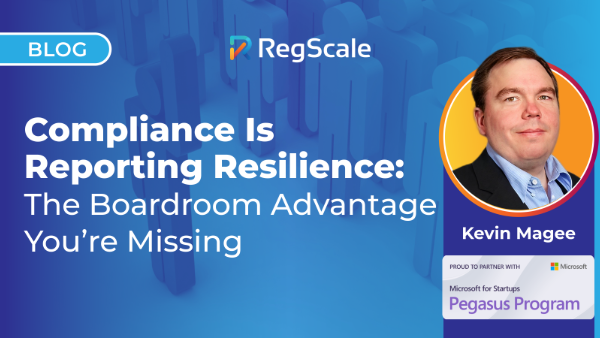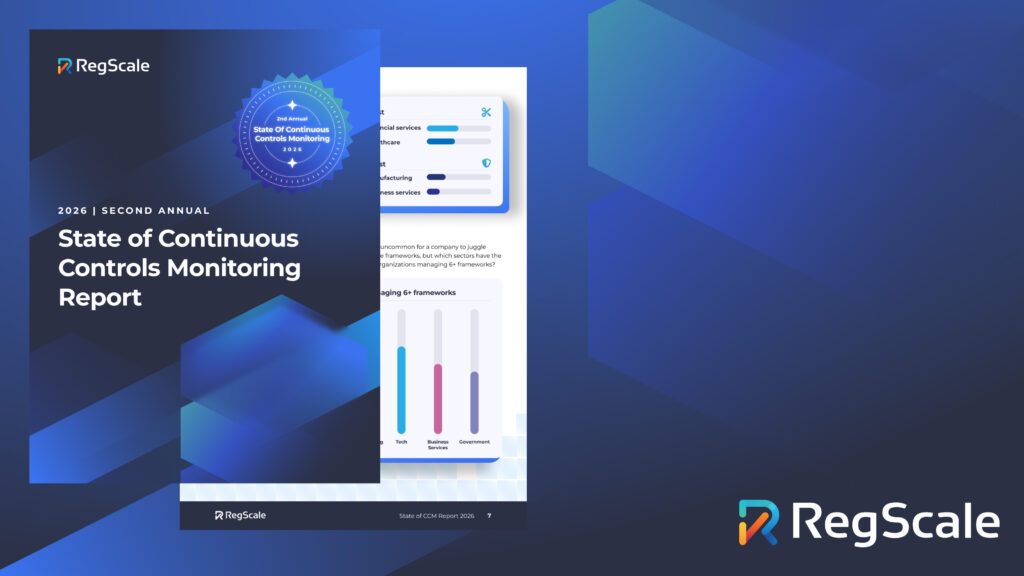Compliance Is Reporting Resilience: The Boardroom Advantage You’re Missing

As a proud member of the Microsoft for Startups Pegasus Program, RegScale is pleased to publish this guest post by Kevin Magee, Global Director of Cybersecurity Startups at Microsoft for Startups.
There was a time when I saw compliance as a necessary nuisance, a checkbox on the way to the real work. It felt a bit like crossing the street within the painted lines: important, sure, but not exactly meaningful. The real value, I believed, came from security. Security was dynamic. It meant looking both ways, anticipating threats, and reacting in real time to avoid getting hit by the proverbial truck. Compliance, by contrast, was just about staying in the lines to avoid a ticket, something you did because someone might be watching, not because it added real value.
That mindset, I’ll admit, was limited. And it began to shift the more I worked with compliance experts like Dale Hoak from RegScale and colleagues like Jason Bero at Microsoft Canada. But it was one sentence from Dale that crystallized the transformation in my thinking:
“Compliance is reporting resilience.”
Those five words are more than a catchy phrase. They encapsulate a profound shift in how we should be thinking about compliance in a world of accelerating risk and constant change.
The Problem with Point-in-Time Thinking
Most organizations still treat compliance as a periodic exercise. They collect documentation, review controls, and prepare for audits with an eye to checking the boxes and avoiding penalties. Then, they put it all away until the next cycle.
That model may have worked when the pace of business and risk was slower. But today, change is constant. AI is reshaping workflows overnight. Data moves fluidly across cloud, hybrid, and on-prem environments. Threats are evolving faster than traditional audit cycles can keep up. Point-in-time compliance simply cannot reflect the dynamic risk landscape organizations now face.
The traditional approach to compliance offers a rearview mirror in a world that demands a live dashboard.
Turning Compliance into a Living Pulse
The paradigm is shifting. Compliance is no longer a static record of the past. It is becoming a dynamic indicator of organizational health, risk posture, and operational readiness.
Microsoft Purview lays the foundation for this new model by delivering intelligent data classification, labeling, and posture management. RegScale extends that capability, automating how those insights are codified, reported, and acted upon. Together, they enable organizations to transform compliance from a lagging indicator into a leading one.
Dale Hoak describes this approach as dynamic operational control assurance: a system where your control health is monitored continuously, your vulnerabilities are surfaced in real time, and your teams are empowered to act proactively.
What Boards Actually Want
Having served on boards and audit committees, I’ve seen firsthand that leadership isn’t asking for more data. They are asking for more clarity. They don’t want to wade through endless spreadsheets or decipher technical jargon. What they want is confidence. They want to understand the organization’s resilience. Where are the exposures? What’s being done to manage them?
Filling the board package with static metrics and heat maps might check a box, but it doesn’t change the conversation. What does is this new approach: shifting from point-in-time reporting to continuous, real-time visibility into compliance posture and risk exposure. It enables leadership to fulfill their oversight responsibilities with far greater accuracy and timeliness.
Crucially, this paradigm shift moves the responsibility for defining risk tolerance and owning the risk conversation out of IT and into the boardroom, where it belongs. Too often, IT and security leaders are left to make judgment calls about what level of risk is acceptable to the business. That is never where that decision should have lived. With modern compliance tooling, boards are no longer passive recipients of historical data. They become active participants in setting risk priorities and overseeing performance against them. And when they see that level of visibility and control, they are far more likely to support the resources and investment needed to stay ahead of risk.
Resilience as a Strategic Asset
Security and compliance are not separate pursuits. They are two expressions of the same goal: resilience. Security ensures defenses are effective. Compliance ensures they are applied consistently and visibly. Together, they create a continuous loop of improvement: detect, respond, report, adapt.
As Dale has pointed out to me, “you can’t hire your way to control assurance.” In a world of constrained resources and rising complexity, automation is not a luxury. It is a necessity. And operationalizing your tech stack, your controls, and your reporting isn’t just good governance; it’s good business.
Most importantly, we must present compliance in a way the business can understand. Not in acronyms or audit logs, but in risk-adjusted, board-ready narratives that reflect the organization’s ability to withstand disruption.
A New Language for Leadership
If compliance is reporting resilience, then we need to ask: what are we really showing the business? Is it a record of what happened or a signal of where we stand right now?
What leaders truly need isn’t more reports or metrics. They need a clear line of sight into the health of the organization, delivered in time to act. Modern compliance tools make that possible, not as an annual event but as a continuous capability. When compliance becomes part of the daily rhythm of the business, it stops being a snapshot of the past and starts becoming a reflection of reality.
This is how we shift compliance from a burden to a benefit, from something we do after the fact to something that informs how we move forward.
That’s not just resilience. That’s advantage.
Ready to get started?
Choose the path that is right for you!
Skip the line
My organization doesn’t have GRC tools yet and I am ready to start automating my compliance with continuous monitoring pipelines now.
Supercharge
My organization already has legacy compliance software, but I want to automate many of the manual processes that feed it.

